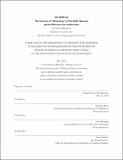| dc.contributor.advisor | Timothy Hyde and Azra Aksamija. | en_US |
| dc.contributor.author | Zilberman, Nitzan. | en_US |
| dc.contributor.other | Massachusetts Institute of Technology. Department of Architecture. | en_US |
| dc.date.accessioned | 2020-01-23T17:00:22Z | |
| dc.date.available | 2020-01-23T17:00:22Z | |
| dc.date.copyright | 2019 | en_US |
| dc.date.issued | 2019 | en_US |
| dc.identifier.uri | https://hdl.handle.net/1721.1/123615 | en_US |
| dc.description | This electronic version was submitted by the student author. The certified thesis is available in the Institute Archives and Special Collections. | en_US |
| dc.description | Thesis: S.M., Massachusetts Institute of Technology, Department of Architecture, 2019 | en_US |
| dc.description | Cataloged from PDF version of thesis. | en_US |
| dc.description | Includes bibliographical references (pages 83-84). | en_US |
| dc.description.abstract | The focal point of this thesis is the turn from the display of objects to the display of environments, a change that blurs the line between the body and the display, and questionably absorbs the subject into the object. The Selfie Museum epitomizes this cultural shift. In The Selfie Museum, subject and object aren't the sole dichotomies that are conflated: physical space combines with virtual image; the still moment merges with the temporal experience; two dimensional projections are overlaid onto three dimensional structures. As a result, architects become "experience designers," virtual reality is a mode of design practice, and an "instagrammable" moment is a project deliverable. This thesis simultaneously acknowledges these changes and critiques them. At the same time, it offers the combination of apparent oppositions as a potential new set of tools that can help rethink aspects of our profession. Although The Selfie Museum is another form of entertainment that will come and go, examining this typology allows me to question how these spaces are embedded in culture; challenging traditional museum displays, body image perceptions, and the basic concept of a tourist destination. The etymology of the word "display" means to unfold, scatter, reveal. This thesis seeks to unfold a few new understandings about Architecture using The Selfie Museum, or a few new Observations on The Selfie Museum using Architecture. | en_US |
| dc.description.statementofresponsibility | by Nitzan Zilberman. | en_US |
| dc.format.extent | 85 pages | en_US |
| dc.language.iso | eng | en_US |
| dc.publisher | Massachusetts Institute of Technology | en_US |
| dc.rights | MIT theses are protected by copyright. They may be viewed, downloaded, or printed from this source but further reproduction or distribution in any format is prohibited without written permission. | en_US |
| dc.rights.uri | http://dspace.mit.edu/handle/1721.1/7582 | en_US |
| dc.subject | Architecture. | en_US |
| dc.title | On display : the strategy of "flattening" in the Selfie Museum and its relevance for architecture | en_US |
| dc.title.alternative | Strategy of "flattening" in the Selfie Museum and its relevance for architecture | en_US |
| dc.type | Thesis | en_US |
| dc.description.degree | S.M. | en_US |
| dc.contributor.department | Massachusetts Institute of Technology. Department of Architecture | en_US |
| dc.identifier.oclc | 1135874899 | en_US |
| dc.description.collection | S.M. Massachusetts Institute of Technology, Department of Architecture | en_US |
| dspace.imported | 2020-03-09T19:59:39Z | en_US |
